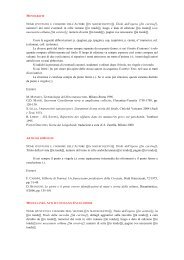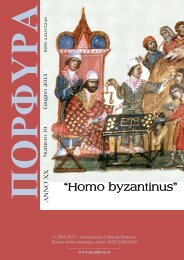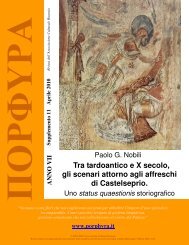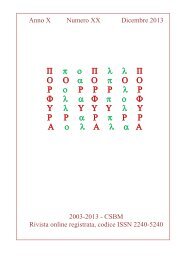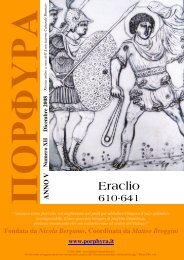ΠΟΡΦΥΡΑ - Porphyra
ΠΟΡΦΥΡΑ - Porphyra
ΠΟΡΦΥΡΑ - Porphyra
Create successful ePaper yourself
Turn your PDF publications into a flip-book with our unique Google optimized e-Paper software.
A Prôtospatharios, Magistros, and Strategos Autokrator of 11 th cent.<br />
the equipment of Georgios Maniakes and his army according to the Skylitzes Matritensis miniatures<br />
and other artistic sources of the middle Byzantine period.<br />
Age and worn by the Varangians coming to Byzance, as showed<br />
by the finds of Zalatovye nearby Novgorod 272 . The bands,<br />
measuring from the surviving fragments, were usually 75-100<br />
mm. broad, and the weave, as the way of wrapping, was almost<br />
invariably of “herringbone” type, as shown in fig. 10,13 and<br />
plate 1B. The most usual colours, lichen purple and indigotin<br />
(blue from woad) were the commonest. The enamel in fact<br />
shows light blue and dark blue wickelbander 273 .<br />
These bands were a kind of "puttees", spiral wrappings<br />
for the lower leg, so often seen in artistic illustrations 274 . The<br />
stretchiness of herringbone weave makes it particulary suited to<br />
this type of function. Fastening must usually have been<br />
accomplished by simply tucking in the loose ends, but there is<br />
evidence of more elaborate systems. Ties below the knee with<br />
tassels or tags were usually used, in the fashion of tablet woven<br />
garters to fasten the chevron twill puttees. The garters often had<br />
plaited terminals interlaced with coils of bronze wire,<br />
particularly in the Baltic Regions. A pair of hooks were found<br />
below the kneecaps of a 10 th cent. male skeleton in Birka and<br />
Novgorod Graves (fig. 13 n. 32) 275 . About the total length, we<br />
can suppose a a medium length from 2,5 to 3 m. 276<br />
This Northman finally wears the feet enclosed in short<br />
shoes, probably to identify with those used by infantry and<br />
called mouzakia in tactic lexicon 277 .<br />
In our reconstruction, there is a touch of colour on his<br />
hand : the tattooing of hands and arms up to the shoulder was a<br />
Rus-Varangian fashion adopted from Asiatic people, so very<br />
often practised by the Guardsmen 278 .<br />
272 Cfr. Beatson P., Wickelbander, in Varangian Voice n. 37 November 1995, pp. 17; Nosov E.N., Ryurik Gorodische<br />
and the settlements to the north of Lake Ilmen, in Brisbane, The archeology of Novgorod, London 1987, pp. 41 ff.;<br />
273 The bands’ remnants from different places in North-Europe (Hedeby and Elisenhof), appeared to have been<br />
artificially coloured red and yellow. In some examples different-colored dark and light warp and weft were used to<br />
accentuate the weaving pattern. Other colours showed by the remnants are orange-brown, black, black-brown, redbrown,<br />
yellow-brown. S. Beatson, Wickelbander, p. 9 and note 10.<br />
274 In East-Roman context, see Bank, Byzantine Art, pp. 187, 190 (may be Varangian figures ?); in western 11 th cent.<br />
context, s. the Bayeux Tapestry in Setton, The Norman conquest, pp. 208, 220, 222, 244-245; and Beatson,<br />
Wickelbander, fig. 7 ;<br />
275 On the reverse of the hooks were remains of woolen twill cloth. The hooks were fastened into small iron rings, on<br />
which linen tabby from the trousers was still found. S. Ardwisson , Birka II, Systematischen Analysen der Gräberfunde,<br />
Stockholm, 1986, pp. 51-72; Nosov, Ryurik Gorodische, pp. 45ff. The fastening system we copied, combining the<br />
specimens of Novgorod hook with that of Lejre, is after Birkebak, Danmarkshistorien, Vikingetiden, I, Copenhagen<br />
1982.<br />
276 Surviving Viking Age band fragments longer than one meter have been reported. A total length of 3,60 m. could be<br />
assumed from the whole reconstruction. S. Beatson, Wickelbander, p. 10-11.<br />
277 Nikephoros Praecepta Militaria I, 3 ; Nikephoros Ouranos I,3 ; both in McGeer, Showing the..., p. 13 and pp.<br />
62,89,205; Kolias, Waffen, p. 72 note 3; for the arabian origin of it see Du Cange commentarii on Pseudo-Kodinos p.<br />
226. S. also Du Cange, Glossarium, col. 959 ;<br />
278 S. Heath, Byzantine Armies, p. 37 ;<br />
44



